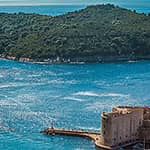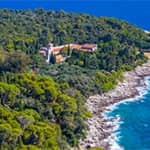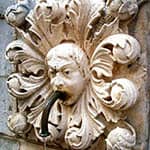During a fierce storm, the king vowed that he would build two churches...
Many foreign rulers visited Dubrovnik throughout its long history. The renowned English king, Richard the Lion-Hearted, was the first among them. It is said that he stopped over on his return from Palestine in the year 1192. All the Dubrovnik chroniclers relate how Richard the Lion-Hearted got caught up in a great storm in the Adriatic Sea, while returning home from the Third Crusades. The King was on a Venetian ship that was taking him home, but the chroniclers erred when they said that the queen was with him as well.

Equally, most chroniclers place the event in the year 1116, whereas Richard actually returned in the fall of 1192. November is a very dangerous month in the Aegean and Adriatic Seas, the month in which the king his return. During a fierce storm, the king vowed that he would build two churches to the Blessed Virgin Mary if he were saved: one on the spot where he would step on land, and the other in England, his homeland.
Dubrovnik Kayaking Tour + Gourmet Lunch On Lokrum Island
For outdoor enthusiasts who also have a passion for fine cuisine, the gourmet kayaking tour of Dubrovnik is a must-do. Experience the popular Dubrovnik Old Town from a unique perspective – the water. Discover hidden caves and cliffs that are difficult to access by any other means. Take a refreshing dip or go snorkelling if you wish. Build up your appetite paddling along the shore before savouring a delectable lunch of authentic Dalmatian cuisine on Lokrum Island.
According to chroniclers, the king's ship took safe shelter next to the island of Lokrum near Dubrovnik, protected by the Blessed Virgin Mary. Not forgetting his promise, the king decided to raise the church he had pledged in this spot.
Dubrovnik, upon learning that such a distinguished guest had arrived, sent a delegation of twelve aristocrats to greet and invite him into the city. The king accepted the invitation and went to Dubrovnik. The authorities gave him great gifts in food and other things, and convicted him to stay until he was rested and well again.
Richard went about fulfilling his vow right away, intending to spend 100,000 ducats. However, the citizens of Dubrovnik requested that he alter his vow and raise a church in Dubrovnik instead. They promised that they would build a smaller church on Lokrum at their own expense. The king agreed to this. Some chroniclers say that he sent a request to the Pope to allow him to do so prior to making any such change. Island Lokrum has its own legends and tales, read more about the Lokrum curse
The citizens of Dubrovnik persuaded Richard to release the Venetian ship that had brought him, and to allow them to transport him further with a ship of their own. The king fulfilled the plea of his new friends and boarded the Dubrovnik ship. Before his departure, he left 100,000 ducats with one of his men in Dubrovnik for the construction of the church, instructing him to watch over its progress. Chroniclers say that 80.000 ducats were needed for the construction alone. The reminder was spent on finishing the interior.
It is said that Richard sailed from Dubrovnik to Ancona, where he then travelled over the European continent to England. Unfortunately, as interesting as this combined story of the Dubrovnik chroniclers appears to be, it cannot be fully accurate. Tadic believes that Richard I came to Dubrovnik, as did other rulers and reputable individuals on their return from Palestine. It could also be tied to some great storm, but one cannot exclude that this story is connected to another storm that King Richard really did experience on the Adriatic Sea. In this storm, he was saved in Aquilea, where he really did disembark, and not in Ancona, as written by the Dubrovnik chroniclers. During the time spent in Dubrovnik, King Richard had surely learned that the citizens of Dubrovnik were planning on building a great church in the honour of the Blessed Virgin Mary. Most likely, this is why he deposited a certain amount of money for this purpose, but on no account could it have been the vast sum of 100,000 ducats, for this was considered a huge fortune, even centuries later. The memory of this gift, which was probably greater than that of others, must have been long kept in Dubrovnik. In this manner, it gave rise to the tale noted by the chroniclers. Perhaps we can even mention the reason for this.
Dubrovnik began to build its great cathedral at the end of the 12th century, for the contract with its builder, Eustache, was made on June 02, 1199. It cannot be excluded that the money donated by the King Richard was the greatest incentive Dubrovnik had for executing their intentions. Most probably, the construction of the Blessed Virgin Mary was tied to Richards's name. The fact that the construction of the church lasted throughout the 13th century shows that the king's gift was insufficient. The Dubrovnik Statute of 1272 set special taxes in order to gather the funds needed for its completion. Even in the first decades of the 14th century, work was not fully completed. Accordingly, the old Dubrovnik cathedral, the beautiful and highly Romanesque building that was destroyed in the great earthquake 1667, was not raised solely on the contributions of the King Richard, but by contributions of the citizens of Dubrovnik themselves.
The story of the storm, Richard's vow and his salvation on Lokrum benefited the Benedictine monastery of St. Mary on this island. Specifically, on the basis of Richard's vow. The abbot of the Lokrum abbey had long since enjoyed the privilege on holding the pontifical mass in the cathedral on Candlemas day, which is celebrated on February 2nd (the day before St Blasius, the patron saint of Dubrovnik), in the presence of the duke and the Dubrovnik government, It was claimed that this right was given to the Lokrum Benedictines as compensation for King Richard's not building a church on their island, as he had first vowed.
Therefore, it is easily possible that the Lokrum monks were the first to start recounting the story of how Richard was saved and of his arrival in Dubrovnik. It cannot be excluded that they were the first ones to note this story, for their monastery was renowned for other forgeries that were used to try and prove their rights or counter any pretensions of the Dubrovnik archbishop.
The Benedictine called upon Richard's vow particularly when the Dubrovnik archbishop began to challenge the rights of Lokrum abbey to hold pontifical masses on Candlemas. In defence of its claim, the Dubrovnik government wrote to the pope on this matter in 1590 and 1597, stating how this was based on the vow made by King Richard. The Dubrovnik archbishop continued to insist that the Lokrum abbey's privilege be removed, and he created difficulties and scandals for the church. Therefore, in February 1598, the Dubrovnik government issued the abbot with a certificate the stated he was completely in the right, on the basis of tradition, and the authenticity of historical documents and written chroniclers. The Pope then annulled the archbishop's decision and allowed the abbot of Lokrum to hold the pontifical Mass in the cathedral on Candlemas.
This officially confirmed version that the cathedral was built as a great votive gift by King Richard the Lion-Hearted, four centuries after his stay in Dubrovnik.
Source: "Dubrovnik - between history and legend"
Writen by: Dr. Marko Margaritoni
The arrival and the departure to and from Lokrum island are organized from the Dubrovnik ancient Old Town port. Regular departures are available every 30 minutes during summer season.
Planing to visit Lokrum Island? Here is the Lokrum Island Ferry Timetable.
Dubrovnik legends and tales

The Legend of the Lokrum Curse
This Lokrum legend is connected to the establishment of the Benedictine monastery on Lokrum Island.
Read more: The Legend of the Lokrum Curse

The wretched woman of Lopud
The legend of the forbidden tragic love between a nobleman and a commoner girl.

Richard the Lion-Hearted´s vow
Regarded as one of the most distinguished Renaissance playwrights and prose writers in Croatian literature.
Read more: Richard the Lion-Hearted´s vow

City Walls Legends and Facts Tour
Gain a genuine understanding of Dubrovnik's life across different eras through tales of legends and customs.
